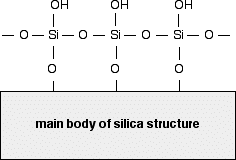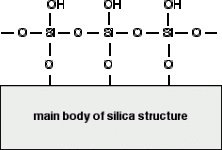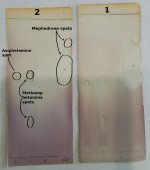G.Patton
Expert
- Joined
- Jul 5, 2021
- Messages
- 2,704
- Solutions
- 3
- Reaction score
- 2,858
- Points
- 113
- Deals
- 1
Introduction.
 How does thin layer chromatography work?
How does thin layer chromatography work?
 Preparing.
Preparing.
Producing the chromatogram.



Take one plastic or glass jar, pour 10-15 ml of water, 4-5 drops of iodine alcohol solution. Stir for 7-10 minutes. Drain the water. Iodine is precipitated in water on sides of the jar. Put this jar into container.
Retention Factor
After a separation is complete, individual compounds appear as spots separated vertically. Each spot has a retention factor (Rf) which is equal to the distance migrated over the total distance covered by the solvent. The Rf formula is Rf= distance traveled by sample/distance traveled by solvent.
 The Rf value can be used to identify compounds due to their uniqueness to each compound. When comparing two different compounds under the same conditions, the compound with the larger Rf value is less polar because it does not stick to the stationary phase as long as the polar compound, which would have a lower Rf value. Rf values and reproducibility can be affected by a number of different factors such as layer thickness, moisture on the TLC plate, vessel saturation, temperature, depth of mobile phase, nature of the TLC plate, sample size, and solvent parameters. These effects normally cause an increase in Rf values. However, in the case of layer thickness, the Rf value would decrease because the mobile phase moves slower up the plate.
The Rf value can be used to identify compounds due to their uniqueness to each compound. When comparing two different compounds under the same conditions, the compound with the larger Rf value is less polar because it does not stick to the stationary phase as long as the polar compound, which would have a lower Rf value. Rf values and reproducibility can be affected by a number of different factors such as layer thickness, moisture on the TLC plate, vessel saturation, temperature, depth of mobile phase, nature of the TLC plate, sample size, and solvent parameters. These effects normally cause an increase in Rf values. However, in the case of layer thickness, the Rf value would decrease because the mobile phase moves slower up the plate.
Results discussion
Methamphetamine - 0.55
Mephedrone - 0.65
Conclusion.
Chromatography is used to separate mixtures of substances into their components. All forms of chromatography work on the same principle. In this article, I will explain this method by defining Rf of Amphetamine Methamphetamine and Mephedrone.
Chromatography plates have a stationary phase (a solid, or a liquid supported on a solid) and a mobile phase (a liquid or a gas). The mobile phase flows through the stationary phase and carries the components of the mixture with it. Different components travel at different rates. We'll look at the reasons for this further down the page. Thin layer chromatography is done exactly as it says - using a thin, uniform layer of silica gel or alumina coated onto a piece of glass, metal or rigid plastic. The silica gel (or the alumina) is the stationary phase. The stationary phase for thin layer chromatography also often contains a substance which fluoresces in UV light or iodine chamber - for reasons you will see later. The mobile phase is a suitable liquid solvent or mixture of solvents.
Chromatography plates have a stationary phase (a solid, or a liquid supported on a solid) and a mobile phase (a liquid or a gas). The mobile phase flows through the stationary phase and carries the components of the mixture with it. Different components travel at different rates. We'll look at the reasons for this further down the page. Thin layer chromatography is done exactly as it says - using a thin, uniform layer of silica gel or alumina coated onto a piece of glass, metal or rigid plastic. The silica gel (or the alumina) is the stationary phase. The stationary phase for thin layer chromatography also often contains a substance which fluoresces in UV light or iodine chamber - for reasons you will see later. The mobile phase is a suitable liquid solvent or mixture of solvents.
Silica gel is a form of silicon dioxide (silica). The silicon atoms are joined via oxygen atoms in a giant covalent structure. However, at the surface of the silica gel, the silicon atoms are attached to -OH groups. So, at the surface of the silica gel, you have Si-O-H bonds instead of Si-O-Si bonds. The diagram shows a small part of the silica surface. The surface of the silica gel is very polar and, because of the -OH groups, can form hydrogen bonds with suitable compounds around it as well as Van-der-Waals dispersion forces and dipole-dipole attractions.
You need:
1. Syringe for 5 ml х 4
2. Plastic urine test jar х 4
3. Big plastic containers for food (or one big beaker and plastic container) х 2
4. TLC plate with silica gel layer 5x10 cm (you can cut big one by scissors)
5. Solvents ethyl acetate, methanol, hexane (can be substituted for carbon tetrachloride), ammonia aqueous solution 10% or higher, iodine alcohol solution
6. Soft pencil, ruler and pliers
Don't forget about gloves and respirator, provide experiment in a ventilated room.
1. Syringe for 5 ml х 4
2. Plastic urine test jar х 4
3. Big plastic containers for food (or one big beaker and plastic container) х 2
4. TLC plate with silica gel layer 5x10 cm (you can cut big one by scissors)
5. Solvents ethyl acetate, methanol, hexane (can be substituted for carbon tetrachloride), ammonia aqueous solution 10% or higher, iodine alcohol solution
6. Soft pencil, ruler and pliers
Don't forget about gloves and respirator, provide experiment in a ventilated room.
Producing the chromatogram.
1. You have to prepare an fluent solution ethyl acetate:methanol:ammonia solution 85:10:5. For 10 ml you need to take 8.5 ml of ethyl acetate, 1 ml of methanol and 0.5 ml of ammonia solution and mix it.
 2. Clean up the plate with silica gel by this solution. Put the plate into the solution, it has to be 3-4 mm of depth in big beaker (as in the pic.1). You can use tweezers for comfortable manipulations. Important: do not wet the plate by water because it will be spoiled. You have to keep the plate into the solution until the front of solvent up to the top edge of the plate.
2. Clean up the plate with silica gel by this solution. Put the plate into the solution, it has to be 3-4 mm of depth in big beaker (as in the pic.1). You can use tweezers for comfortable manipulations. Important: do not wet the plate by water because it will be spoiled. You have to keep the plate into the solution until the front of solvent up to the top edge of the plate.
3. We'll start with a simple case. There are four substances: amphetamine (A), methamphetamine (L), caffeine (K) and mephedrone (M).
For this experiment, you need to get free base of drugs. Put 10-15 mg of the sample (a few lumps) into a glass (plastic) jar, pure two drops of aqueous ammonia solution. Then, pour 3-4 drops of hexane or carbon tetrachloride and shake it one minute. The free base of your drug is diluted in the organic layer.4. Now you need to place it onto chromatography plate, which was prepared early. Take a needle from a syringe and cut it by pliers, as in the example. You need to get flat edge.




 Take a clean and dried plate and draw a pencil line ~5-6 mm up from the bottom edge. Any labelling on the plate to show the original position of the drop must also be in pencil. If any of this was done in ink, dyes from the ink would also move as the chromatogram developed. Mark four dots with equal distance between them. Immerse the end of the clipped needle into the organic layer of first narcotic solution. Touch the plate with the tip of the needle and make a small spot 3-4 mm in diameter, wait until it dry, repeat procedure 10 times. Repeat stages 2, 3 for other substances.
Take a clean and dried plate and draw a pencil line ~5-6 mm up from the bottom edge. Any labelling on the plate to show the original position of the drop must also be in pencil. If any of this was done in ink, dyes from the ink would also move as the chromatogram developed. Mark four dots with equal distance between them. Immerse the end of the clipped needle into the organic layer of first narcotic solution. Touch the plate with the tip of the needle and make a small spot 3-4 mm in diameter, wait until it dry, repeat procedure 10 times. Repeat stages 2, 3 for other substances.
Common mistake: do not make big grease spot, because your substance can overlay another substances during experiment.
5. When spots of free bases are dry, the plate is stood in a shallow layer of solvent in a covered beaker. It is important that the solvent level is below the line with the spot on it. Wait until solvent frontline reach 4-5 mm before the top edge of the plate and pull it out. After, draw a pencil line on the front line of the solvent. Dry it on air.

 6. The chromatogram placed in an enclosed container (such as another beaker covered with a watch glass or big plastic containers) along with a few iodine crystals. The iodine vapour in the container react with spots on the chromatogram. The substances you are interested in may show up as colored spots. Trace them with a pencil and draw dots in the center of each spot.
6. The chromatogram placed in an enclosed container (such as another beaker covered with a watch glass or big plastic containers) along with a few iodine crystals. The iodine vapour in the container react with spots on the chromatogram. The substances you are interested in may show up as colored spots. Trace them with a pencil and draw dots in the center of each spot.
 Also, you can use UV lamp with 254 and 365 nm wavelength.
Also, you can use UV lamp with 254 and 365 nm wavelength.

How to prepear iodine chamber.Common mistake: do not make big grease spot, because your substance can overlay another substances during experiment.
5. When spots of free bases are dry, the plate is stood in a shallow layer of solvent in a covered beaker. It is important that the solvent level is below the line with the spot on it. Wait until solvent frontline reach 4-5 mm before the top edge of the plate and pull it out. After, draw a pencil line on the front line of the solvent. Dry it on air.
Take one plastic or glass jar, pour 10-15 ml of water, 4-5 drops of iodine alcohol solution. Stir for 7-10 minutes. Drain the water. Iodine is precipitated in water on sides of the jar. Put this jar into container.
Retention Factor
After a separation is complete, individual compounds appear as spots separated vertically. Each spot has a retention factor (Rf) which is equal to the distance migrated over the total distance covered by the solvent. The Rf formula is Rf= distance traveled by sample/distance traveled by solvent.
In the experiment I have got three spots instead of expected four. Repeating of the experiment shows that caffeine isn't be eluted by solution of ethyl cetate:methanol:ammonia solution 85:10:5. Experimentally approved that this solution suitable for eluting drugs such as amphetamine, methamphetamine and mephedrone.
 Rf of studied drugs:
Rf of studied drugs:
Amphetamine - 0.53Methamphetamine - 0.55
Mephedrone - 0.65
Explanation.
I have got two plates with results. Two measured distances between the start dot and midle of the encircled spot. Amphetamine spot went 42 in the first plate and 49 mm in the second plate from start line, solvent front line went 85 and 86 mm respectively. Rf1=42/85=0.49, Rf2=49/86=0.52. Then I colculated arithmetical mean 0.53. Same calculations was made for other substances.
I have got two plates with results. Two measured distances between the start dot and midle of the encircled spot. Amphetamine spot went 42 in the first plate and 49 mm in the second plate from start line, solvent front line went 85 and 86 mm respectively. Rf1=42/85=0.49, Rf2=49/86=0.52. Then I colculated arithmetical mean 0.53. Same calculations was made for other substances.
Conclusion.
As experiment shows, you can measure Rf of your drug and compare with known substance in a same plate. Make a spot of your drug free base and 1-4 spots of other drugs to check Rf. If the spots are at the same distance from the starting line, then they are probably the same substance. Also, if you get several spots from your drug, you probably have a mixture of substances. Some drugs have multiple spots because they are a mixture of drug and byproducts of synthesis. However, you can compare them to other drugs using thin layer chromatography.
Attachments
Last edited by a moderator:


